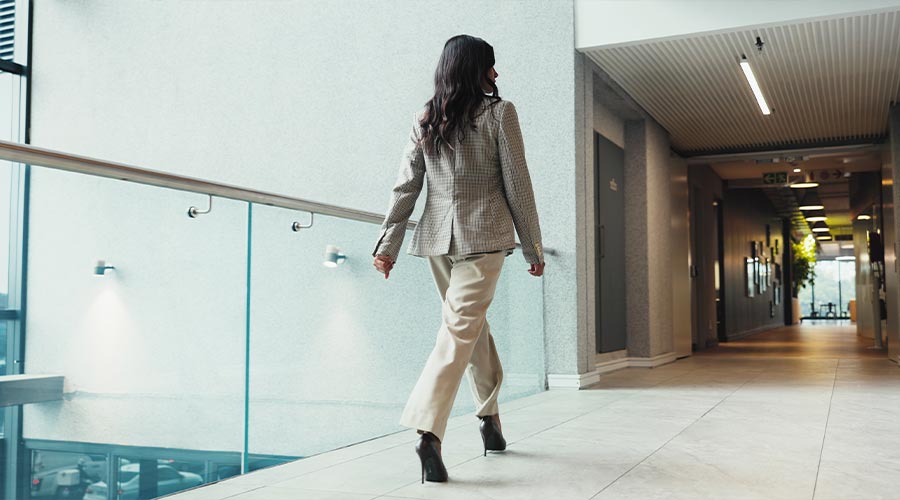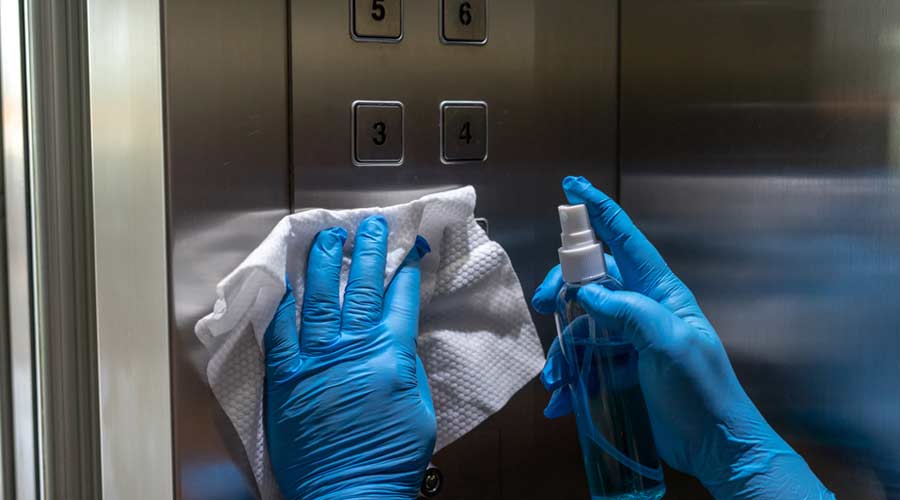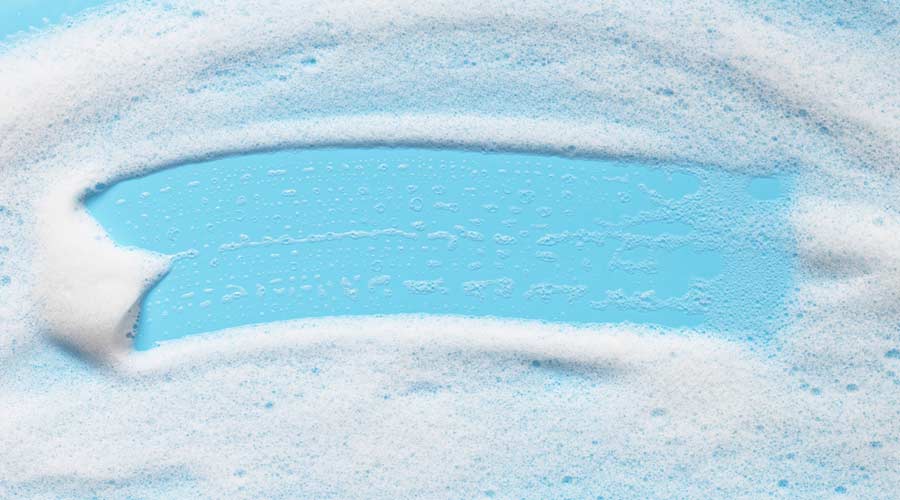
Contributed by Keith Schneringer, LEED AP O+M, Senior Director of Marketing JanSan + Sustainability, BradyPlus
There is a reason why most professionals in the cleaning industry look down when they are evaluating the cleanliness of a facility. Whether it is a prime walking thoroughfare in a large commercial office or retail space, or a more compact hallway in a school or hospital, clean floors play an oversized role in the impression a visitor or building occupant will have of the overall cleanliness of a facility.
Think about it – what is the first thing you notice when you enter a building?
But while we can all agree that there is typically a keen focus on the cleanliness and appearance of the floors in any facility, are we also devoting enough attention to the safety of the floors, and addressing potential hazards that can lead to slips, trips, and falls?
For cleaning professionals, facility maintenance teams, environmental services departments, and custodial staff, I would submit that floor care isn’t just a matter of cleanliness and appearance, it is also a matter of building occupant health and safety, liability mitigation, and operational efficiency.
-
Building Occupant Health + Safety
Unfortunately, slip-and-fall accidents are a leading cause of injuries in workplaces and public facilities. It is estimated that slips and falls result in over 1 million emergency room visits annually. A well-thought-out floor care program, one that keeps floors clean, dry, uncluttered, and properly marked, can dramatically reduce the possibility of these incidents.
-
Liability Mitigation
Injuries related to floor hazards often result in workers’ compensation claims, lawsuits, insurance premium increases, and reputational damage. In addition, facilities that fail to maintain safe flooring conditions may be in violation of OSHA regulations or local building codes. A floor care program that incorporates safety is like a great “insurance policy” to help protect against these risks.
-
Operational Efficiency
Accidents cause downtime, not just for the injured folks but also for the entire workflow. An incident in a key area such as a hospital entrance, a production floor, or a school cafeteria can disrupt operations and require costly emergency cleaning or repairs. Investing in floor care safety can help reduce the likelihood that these disruptions will occur.
The Cleaning Professionals Role in Floor Safety
As you can see, cleaning professionals are on the frontline of floor safety. Their daily routines, equipment choices, chemical usage, and response protocols significantly influence how safe all floor surfaces are in a facility.
So, what are some aspects of floor care safety that can make a difference?
-
Routine Maintenance and Inspection
Regular inspection and ongoing maintenance of floors allow cleaning professionals to identify potential safety hazards early, such as worn-out mats, wet or greasy spots, cracked tiles, or uneven thresholds.
As has been stated, routine floor cleaning isn't just about appearances; it's also about preventive maintenance that helps to mitigate floor safety hazards.
-
Training and Awareness
Routine maintenance and inspections needs to start from the top with management, and there should be a commitment to training cleaning staff in the following areas:
-
Proper use of cleaning chemicals
-
The impact of pH levels on floor coatings
-
Using the right equipment and pads for the floor type
-
Recognizing conditions that increase slip risks (such as humidity, snow, rain, etc.)
Effective cleaning teams are not just cleaning floors every day; they are also evaluating safety risks continuously.
Floor Safety Best Practices
To ensure safe walking surfaces, cleaning and facility maintenance teams should focus on the following core strategies and best practices:
-
Use the Right Cleaning Agents and Methods
-
Match the cleaner to the floor type: For example, neutral pH cleaners for vinyl or linoleum; degreasers for industrial floors.
-
Avoid over-applying chemicals, which can leave slippery residues.
-
Use auto scrubbers or microfiber mops to reduce water usage and improve drying times.
-
Implement Entryway Matting Systems
-
High-quality mats at entrances help trap dirt and moisture before they can get inside.
-
Use scraper mats outside, wiper mats inside, and transition mats in high-traffic areas.
-
Mats should be cleaned regularly to remain effective and free from curling or movement hazards.
-
Maintain Dry Floors
-
Regular mop-ups in “wet zones” such as restrooms and kitchens.
-
Use of “wet floor” signage when mopping or during spills.
-
Weather-related procedures, such as deploying extra mats or absorbent floor runners during rain or snow.
-
Restore and Protect Floor Surfaces
-
Strip and refinish floors as needed to maintain slip resistance.
-
Apply non-slip coatings or floor sealants designed for high-traffic areas.
-
Conduct static coefficient of friction (SCOF) testing to evaluate slip resistance, especially in high-risk zones.
-
Establish a Floor Safety Inspection Program
-
Scheduled walk-throughs to look for hazards.
-
Documenting and prioritizing repairs, such as replacing broken tiles.
-
Engaging safety officers and supervisors in ongoing documented reviews to help provide liability protection in case of claims, showing that reasonable efforts were taken to maintain safety.
Floor Safety Challenges
Different building environments present their own unique cleaning and floor safety challenges. Here’s a breakdown:
-
Healthcare Facilities
-
High-risk slip zones include surgical wings, emergency rooms, and patient bathrooms.
-
Floors must be sanitized and slip-resistant, requiring special products and protocols.
-
Noise and odor concerns mean that quiet, non-disruptive equipment and low odor chemistry are essential.
-
Commercial Real Estate Offices
-
Risks increase in lobbies, elevators, and break rooms.
-
Cleaning crews often work after hours, meaning hazards like wet floors may not be noticed until the next day.
-
Floor finishes must balance aesthetic appeal and safety.
-
Retail Stores
-
High foot traffic, food spills, and weather tracking all increase slips, trips, and fall risk.
-
Retailers often struggle with balancing floor shine and floor traction, so finding the right balance is important.
-
Communication with store managers is vital for spill response and hazard reporting.
-
Schools and Universities
-
Students running or playing pose natural risks for slips, trips, and falls.
-
Cafeterias and locker rooms require extra vigilance and attention to floor safety.
-
Routine cleaning should align with class schedules and after-school activities to minimize disruptions and risk.
Supporting Safer Floors
Fortunately, advancements in cleaning equipment, devices, and software have made it easier for custodians to maintain floor safety. Tools include:
-
Smart Auto Scrubbers
-
Offer precise water and chemical usage.
-
Feature real-time alerts for slippery zones or obstructions.
-
Moisture Sensors
-
Can detect wet floors and integrate with alarm systems or building automation platforms.
-
Slip-Resistance Testing Devices
-
Measure Static Coefficient of Friction (SCOF) or Dynamic Coefficient of Friction (DCOF) and can be used to evaluate surfaces before and after cleaning.
-
CMMS (Computerized Maintenance Management Systems)
-
Help schedule floor maintenance.
-
Store inspection data, logs, and accident reports.
-
Ensure compliance with internal protocols and external regulations.
Spills are a fact of life, but response times and organizational effectiveness can help be the difference between a floor hazard and floor safety. A good cleaning team’s emergency spill response should include:
-
Immediate area control: Use barricades and signs.
-
Fast cleanup: Use absorbent materials and clean/dry quickly.
-
Communication: Notify supervisors and building occupants.
-
Documentation: Record the spill, actions taken, and any witness statements.
Building a Floor Safety Culture
Even the best cleaning practices can’t succeed in a vacuum. Creating a floor safety culture involves:
-
Employee engagement: Encourage staff to report spills or hazards.
-
Clear signage and communication: Label hazards clearly and consistently.
-
Leadership buy-in: Managers and administrators must prioritize safety budgets and recognize custodial contributions.
-
Regular training and updates: Keep staff informed of new products, techniques, and risks.
Floor safety is not just about mopping and polishing the floors to create a great first impression. Floor safety is a complex, ongoing commitment involving the right products and equipment, proactive inspections, informed cleaning teams, and a safety-first culture. For facility managers, maintenance teams, and cleaning professionals, the floor is one of their primary areas of responsibility. With proper care and oversight, floors throughout the facility can become safer, more functional, and more inviting to anyone who walks through the door.
By focusing on good sound cleaning procedures, the powers of observation, and an ongoing culture of floor safety and hazard prevention, cleaning professionals can transform everyday floor surfaces into safe passageways that protect building occupants, reduce organizational liabilities, and keep operations running smoothly.
Keith Schneringer has been in the sanitary supply industry since 1990 and is currently the Senior Director of Marketing Jan/San + Sustainability for BradyPLUS, a specialized distributor and solution provider in facility care, foodservice, and industrial packaging. In his current role, Keith is responsible for marketing to the jan/san and facility care industry, for developing vertical-market-specific programs to better assist customers, and for leading the company's sustainability initiatives. Before assuming his current responsibilities, he worked as an account consultant, sales manager, marketing manager, and director of channel marketing + sustainability for WAXIE Sanitary Supply.
posted on 10/14/2025

 The Down and Dirty on Cleaning in Virus Season
The Down and Dirty on Cleaning in Virus Season How Surfactant Use is Expanding in Commercial Cleaning
How Surfactant Use is Expanding in Commercial Cleaning